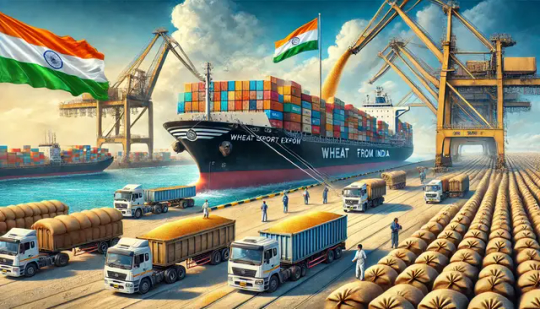#hscodes
Explore tagged Tumblr posts
Text
Five Product Classification Standards
When managing Product Master Data Management (MDM) and Product Information Management (PIM), product classification perhaps the most important aspect. More than often is companies neglecting adapting to external classification standards, and placing their focus on Implementing internal classifications, such as product groupings and hierarchy structures. Five External Standards to rule them…
#B2B#ClassificationStandards#CommodityCodes#DataGovernance#DataManagement#dataquality#DigitalSupplyChain#eClass#Ecommerce#ERP#ETIM#GlobalTrade#GPC#GS1#HSCodes#IndustryStandards#masterdata#PIM#Procurement#ProductClassification#ProductData#ProductHierarchy#Standardization#UNSPSC
0 notes
Text
https://www.seair.co.in/hs-codes.aspx

Seair Exim Solutions is a leading best export-import data provider, offering comprehensive insights into international business focusing on HS Codes. Unlock the power of accurate and up-to-date information for your import-export ventures, ensuring seamless compliance and strategic decision-making.
0 notes
Text
https://www.seair.co.in/hs-codes.aspx

Seair Exim Solutions simplifies global trade with its powerful HSN code lookup tool. Easily identify the correct HSN codes for any product, ensuring seamless customs clearance and accurate duty calculations. Stay consistent and increase efficiency with Sear Exim Solutions' expertly designed HSN code solutions.
0 notes
Text
Wheat Export from India: 2025 Insights, HS Codes, and Key Data
India’s role in the global agricultural market has grown exponentially, especially as one of the world’s leading wheat producers. With rising global demand, competitive pricing, and government support, wheat export from India has become a cornerstone of the nation’s trade strategy. This article explores the latest trends, wheat export data, key destinations, wheat HS codes, and the largest exporter of wheat in India, offering a comprehensive guide for businesses looking to navigate this dynamic sector.

India’s Wheat Production and Export Landscape
India ranks as the world’s second-largest wheat producer, trailing only China. States like Uttar Pradesh, Punjab, Haryana, and Madhya Pradesh contribute over 90% of the country’s output. However, recent years have seen a shift in priorities. In 2024, wheat export from India dropped to $56 billion, a stark decline from previous years. This reduction stems from government policies prioritizing domestic consumption over exports since May 2022. Despite this, India continues to supply wheat to nations like Bhutan, Mali, Senegal, Gambia, and Indonesia under specific agreements.
The outlook for 2025 remains optimistic, with opportunities to expand into new markets and strengthen trade ties. Factors such as improved irrigation, high-yield seed varieties, and diversified wheat types (including durum and bread wheat) position India to meet global demand.
Wheat Export Data and Market Trends for 2025
According to wheat export data, India shipped 5,352 cargoes of wheat flour between March 2023 and February 2024, a 425% year-on-year increase for February 2024 alone. Key markets like the UAE, the USA, and Australia dominate wheat flour export from India, while Turkey, Ukraine, and India itself lead global wheat flour exports.
Despite restrictions imposed in 2022 to stabilize domestic supply, the government authorized limited exports to address food security needs in partner nations. For instance, India approved 2 lakh tonnes of export of flour from India to Nepal in 2025, reflecting strategic trade alliances.
Key Destinations for Wheat Flour Export from India
The top importers of Indian wheat flour include:
Sri Lanka ($1.05 million)
United Arab Emirates ($664 thousand)
Italy ($265 thousand)
Turkey ($50 thousand)
Thailand ($13.1 thousand)
These countries rely on India’s high-quality, competitively priced wheat products. The export of flour from India also extends to niche markets in Africa and Southeast Asia, driven by trade liberalization and government initiatives.
Understanding Wheat HS Codes for International Trade
Accurate classification using wheat HS codes is critical for smooth customs clearance and compliance. Below are the primary HS codes for wheat and related products:
100111: Durum wheat seeds
100119: Durum wheat (excluding seeds)
110100: Wheat flour or meslin
110311: Wheat groats and meal
11010000: Specific HS code for wheat flour
These codes streamline the wheat export from India, ensuring exporters meet international standards. Businesses must stay updated on regulatory changes to avoid delays.
Top India Wheat Exporters and Their Global Reach
The India wheat exporters leading the market include:
Shri Mahavir Agritech (largest exporter of wheat in India)
Pisum Foods Services
Amoli International
A-1 Overseas
ECO Export
These firms leverage India’s robust production capabilities to serve markets in the Middle East, Africa, and Europe. Shri Mahavir Agritech, for instance, has established a strong reputation for quality and reliability, reinforcing India’s position in global trade.
Navigating the Export of Flour from India: Challenges and Opportunities
While the wheat flour export from India sector is promising, exporters face hurdles such as fluctuating domestic policies, rising input costs, and logistical bottlenecks. The 2022 export ban highlighted the fragility of relying on volatile government regulations. Additionally, challenges like labor shortages and small land holdings impact scalability.
However, opportunities abound. Diversifying into value-added products like fortified flour, targeting emerging markets in Africa, and adopting advanced agricultural technologies can drive growth. Platforms like ExportImportData.in provide actionable wheat export data, helping businesses identify trends and buyers.
How to Access Reliable Wheat Export Data
For exporters, accessing accurate wheat export data is vital for strategic planning. Platforms like ExportImportData.in offer real-time insights into global trade trends, competitor analysis, and buyer-seller databases. This information helps businesses optimize supply chains, comply with wheat HS code regulations, and explore new markets for wheat flour export from India.
Final Thoughts
India’s wheat export sector is poised for growth in 2025, driven by rising global demand and strategic government partnerships. By leveraging reliable wheat export data, understanding HS codes, and collaborating with top India wheat exporters, businesses can capitalize on this momentum. Whether you’re exploring the export of flour from India or seeking the largest exporter of wheat in India, staying informed is key to thriving in this competitive market.
0 notes
Text
How to Import Furniture from Indonesia: Key Insights, Steps, and Statistics
Importing furniture from Indonesia presents a lucrative business opportunity due to the country's reputation for high-quality craftsmanship and reasonable prices. Whether you are a seasoned importer or new to the trade, understanding Indonesia's furniture import data, key steps, required documents, and the applicable HS codes is crucial for a smooth and successful importing experience. In this article, we will cover everything you need to know, from market research to finding reputable suppliers, so you can confidently import furniture from Indonesia.

Overview of Indonesia’s Furniture Import Market
Indonesia is a significant player in the global furniture trade, known for its high-quality craftsmanship, especially in outdoor and teak furniture. Based on data from March 2023 to February 2024, 10,757 shipments of furniture were imported globally from Indonesia, marking a 2% year-over-year increase. This growth highlights Indonesia’s strong presence in the furniture market. The United States, India, and Russia lead in global furniture imports, with the US importing over 4.5 million shipments, making it the largest furniture importer from Indonesia.
However, February 2024 saw a decline in furniture imports from Indonesia, with 403 shipments—a sequential drop of 26% from January 2024 and a 60% year-over-year decrease compared to February 2023. Despite this short-term dip, the global demand for Indonesian furniture remains strong, particularly in the US, India, and Russia.
Why Does Indonesia Import Furniture?
Despite being a major exporter of furniture, Indonesia imports furniture to meet the demand for diverse styles and choices in its local market. While the country’s furniture industry focuses heavily on exports, this has led to criticism for neglecting the domestic market. The local demand is especially strong in the middle-to-upper market segments, where international brands like IKEA have seen significant growth.
In 2022, Indonesia recorded a total import value of $331 million USD for furniture, with $290 million USD coming from China. This reflects the country’s reliance on imports to cater to the local market’s evolving preferences.
Key Steps to Import Furniture from Indonesia
Step 1: Market Research and Requirements
Before importing furniture, it's essential to research the market and understand the types of furniture in demand. Whether it’s office furniture, home decor, or high-end custom pieces, knowing local design preferences and materials will help you choose the right products.
Step 2: Registering a Legal Entity
To import furniture, you must first establish a legal business entity in Indonesia. Foreign investors can set up either a PT PMA (Foreign-Owned Limited Liability Company) or a Local PT (Limited Liability Company), depending on their specific business needs.
Step 3: Obtaining Necessary Documents and Licenses
To legally import furniture into Indonesia, several key documents are required:
Import License
Letter of Credit
Bill of Entry
Country of Origin Certificate
Commercial Invoice
Customs Clearance
Export License
Step 4: Understanding HS Codes and Import Duties
Furniture imports fall under Chapter 94 of the HS Code. The applicable codes include:
Wooden furniture: HS Code 9403.60
Metal furniture: HS Code 9403.20
Plastic furniture: HS Code 9403.70
Import duty rates in Indonesia typically range from 5% to 20%, depending on the material, type of furniture, and country of origin.
Step 5: Marketing and Selling Imported Furniture
Once you've imported the furniture, it’s essential to market your products effectively. Whether you’re selling through physical stores or online platforms, a robust marketing strategy will help you succeed. Additionally, using platforms like IndonesiaTradeData.com to access shipment data and analyze market trends will provide valuable insights for scaling your business.
Indonesian Teak Furniture Imports
Teak furniture, especially popular in outdoor settings, is a major export product for Indonesia. Between November 2022 and October 2023, Indonesia imported three shipments of teak wood, marking a 200% year-over-year increase. Despite the small number of shipments, this growth highlights the rising demand for teak wood imports.
India, the United States, and the United Kingdom are the top importers of Indonesian teak wood, with India leading the way, importing 73,835 shipments, followed by the US and the UK.
Finding Outdoor Furniture Suppliers in Indonesia
Finding reliable furniture suppliers is crucial for a successful import business. IndonesiaTradeData.com is a useful platform for accessing updated data on Indonesian outdoor furniture suppliers, including shipment values, port details, HS Codes, and more. This data-driven approach will help you make informed decisions when selecting suppliers.
Conclusion
Importing furniture from Indonesia can be a profitable venture if approached with the right strategy. By conducting thorough market research, registering your business, obtaining the necessary documents, and using accurate data insights, you can successfully navigate the Indonesian furniture import process. Platforms like IndonesiaTradeData.com offer valuable resources for analyzing market trends and connecting with reliable suppliers, helping you grow your business in the competitive global furniture market.
FAQ
What are the key steps to importing furniture from Indonesia?
Find a reputable supplier, obtain necessary permits and licenses, prepare export documentation, and access reliable import-export data.
Which documents and licenses are required to import furniture into Indonesia?
You will need an Import License, General Import License (API-U), Certificate of Origin, and a Commercial Invoice, among other documents.
Why does Indonesia import furniture despite being a major exporter?
Indonesia imports furniture to meet local demand, particularly for international brands, due to the focus on exports leaving gaps in the domestic market.
#FurnitureImports#IndonesiaFurniture#TeakFurniture#OutdoorFurniture#ImportBusiness#IndonesiaTrade#FurnitureSuppliers#IndonesiaTeak#HSCode#FurnitureImportData#ExportImport#ImportLicenses#FurnitureIndustry#GlobalTrade#TeakWood#MarketResearch#FurnitureExport#IndonesiaBusiness
0 notes
Link
Guide to Customs Tariff Classification in Indonesia
#BTI#ImportRegulations#CustomsDuties#CustomsLaw#Tradeagreements#HSCode#tariffclassificationprocess#Indonesia#customstariffclassification#Compliance
0 notes
Video
youtube
মূলধনী মেশিনারিজ এর এস আর ও এবং সিপিসি।। S R O AND CPC OF Capital Mach...
#youtube#মূলধণীযন্ত্রপাতি sro undertakin প্রত্যয়নপত্রর capitalmachime hscodeformachime export import billofentry asycuda++ cpc hscode asycudaworld
0 notes
Text
https://www.seair.co.in/hs-code-search.aspx

Seair Exim Solutions offers unparalleled expertise in global trade data, empowering businesses to effortlessly search HS code and navigate international markets. Unlock the potential of precise HS code classification with Seair's comprehensive database, ensuring seamless trade compliance and strategic decision-making.
0 notes
Text
https://www.seair.co.in/us-import-data.aspx

Seair Exim Solutions is your gateway to unique insights with comprehensive US shipment data. Stay ahead in the competitive market by using real-time information on imports and exports to the United States for strategic decision-making and business success.
0 notes
Text
India’s Castor Oil Export Dominance: Data, HS Codes, and Global Trade Insights
India’s agricultural and industrial prowess shines brightly in its castor oil exports. As the world’s largest producer and exporter of castor oil, India supplies a staggering 85–90% of global demand, making it an indispensable player in industries ranging from pharmaceuticals to renewable energy. With exports worth $1.009 billion in 2023–24, the nation’s castor oil trade is a testament to its strategic agricultural practices and robust export infrastructure. In this blog, we’ll unpack critical data on castor oil export from India, decode essential HS codes for castor oil, and explore how businesses can leverage this thriving market.

Castor Oil Production in India: The Backbone of Global Supply
India’s dominance in castor oil begins with its unparalleled production capacity. The country produces approximately 800,000 tonnes of castor oil annually, accounting for 92% of global output. Gujarat, contributing 85% of India’s production, is the epicenter of cultivation, followed by Rajasthan, Tamil Nadu, and Maharashtra.
Castor seeds, the raw material for oil extraction, thrive in India’s semi-arid climate, requiring minimal irrigation. This resilience, combined with government support for farmers, ensures a steady supply chain. Over 60% of India’s castor oil production is exported, fueling industries worldwide.
Castor Oil Export Data 2023–24: India’s Record-Breaking Year
The 2023–24 fiscal year marked a historic milestone for castor oil export from India:
Export Value: $1.009 billion
Volume Shipped: 629 million kg
Cargoes: 12,347 shipments
Exporters: 1,153 Indian suppliers
Buyers: 4,156 international clients (a 39% YoY increase)
China emerged as the largest importer, purchasing 501.79millionworthofcastoroil.OthertopdestinationsincludetheNetherlands(501.79millionworthofcastoroil.OthertopdestinationsincludetheNetherlands(120.54 million), the United States (96.62million),andFrance(96.62million),andFrance(74.87 million).
HS Codes for Castor Oil: Your Gateway to Compliance
Navigating international trade requires precision in product classification. Below are the critical HS codes for castor oil:
15153090: Pure castor oil (most commonly used)
151530: Fixed vegetable fats, including castor oil
15153010: Refined castor oil
34021300: Ethoxylated castor oil (used in cosmetics and lubricants)
Using the correct HS code ensures smooth customs clearance and compliance with destination-country regulations.
Top Destinations for Castor Oil Export from India
India’s castor oil reaches over 100 countries, but these markets dominate:
China ($501.79 million)
Netherlands ($120.54 million)
United States ($96.62 million)
France ($74.87 million)
Japan ($26.82 million)
These nations rely on Indian castor oil for manufacturing biofuels, cosmetics, pharmaceuticals, and industrial lubricants.
Global Castor Oil Exporters: India Leads, Others Follow
While India reigns supreme, other countries contribute to global trade:
Netherlands ($47.73 million)
France ($29.68 million)
Germany ($26.24 million)
United States ($16.91 million)
Brazil ($9.42 million)
Many of these nations re-export refined castor oil derivatives, highlighting India’s role as the primary supplier of raw and semi-processed oil.
Castor Oil Exporters in India: Key Players
Several Indian companies drive this booming trade:
Amee Castor & Derivatives Ltd
Jayant Agro-Organics Ltd
Royal Castor Products Ltd
Gokul Overseas
RP.K. Agrotech Exports Pvt. Ltd.
These firms adhere to stringent quality standards, ensuring India’s reputation as a reliable supplier.
How to Export Castor Oil from India: A Step-by-Step Guide
Quality Selection: Choose grades meeting international phytosanitary norms. Opt for oils with low moisture content and high ricinoleic acid levels (85–90%).
Documentation: Secure an Import-Export Code (IEC), APEDA registration, and phytosanitary certificates.
Packaging: Use ISO-certified containers. Label shipments with product details, batch numbers, and exporter information.
Partner Identification: Connect with buyers via platforms like Exportimportdata.in, trade fairs, or B2B portals.
Logistics: Collaborate with freight forwarders specializing in edible oils. Ensure bills of lading, invoices, and packing lists are accurate.
Finding Buyers for Castor Oil: Data-Driven Strategies
Platforms like Exportimportdata.in offer real-time castor oil export data, including:
Buyer/supplier databases
Pricing trends
Customs shipment records
Competitor analysis
Such tools empower exporters to identify high-demand markets and negotiate favorable terms.
Why Castor Oil? Global Applications Fueling Demand
Castor oil’s versatility drives its demand:
Pharmaceuticals: Used in capsules and anti-inflammatory drugs.
Cosmetics: A key ingredient in lipsticks, soaps, and hair oils.
Industry: Vital for bio-lubricants, nylon-11, and renewable plastics.
Food: Approved as a food additive (E1503) in many countries.
Final Words: Seize India’s Castor Oil Export Opportunity
India’s castor oil export industry offers immense potential for businesses ready to navigate its complexities. By leveraging accurate castor oil export data, adhering to HS code guidelines, and partnering with reliable platforms like Exportimportdata.in, exporters can tap into a $1.3 billion global market (projected to grow at 4.8% CAGR until 2030).
Whether you’re a startup or an established enterprise, the time to act is now. For customized insights into castor oil export from India, connect with experts at Exportimportdata.in and transform data into actionable strategies.
0 notes
Link
Panduan Lengkap untuk Mendapatkan HS Code dengan Mudah
#tarif#PengirimanInternasional#logistik#perdaganganinternasional#kepabeanan#Ekspor#kodetarif#kodeharmonisasi#Impor#HSCode#beamasuk
0 notes
Photo

HS Codes: The complete guide to understanding HS Codes for International Shipping
HS Codes can be a nightmare to understand: from identifying the right one for your products, to knowing what to do with them when you have them. But don't worry. We have you covered. Read our complete guide to understand: what HS Codes are, why are they important, and how to use them. Check it out here: https://www.sendcloud.co.uk/hs-code/
Photo by Artem Beliaikin on Unsplash
0 notes
Link

Visit the web portal of SEAIR Exim Solutions to download the updated #ListofHSCodes. HS codes, also called HS numbers, are used by customs authorities around the world to identify the duty and tax rates for specific types of products.
0 notes
Link
The #HScode is organized into 21 sections, which are subdivided into 96 chapters. Then these 96 HS chapters are further subdivided into approximately 5,000 headings and subheadings. The #HSNcode is key for easier trade functions around the globe.
0 notes
Link

The Nine unique vostro accounts have been opened with two Indian banks with approval from the Reserve Bank of India to facilitate rupee transactions abroad, a central government official recently disclosed.
0 notes